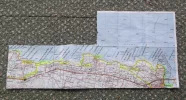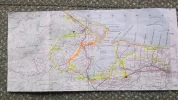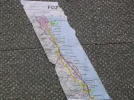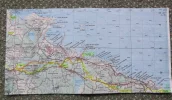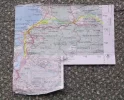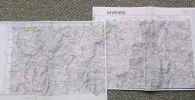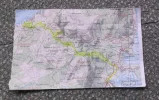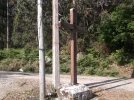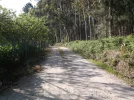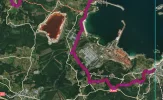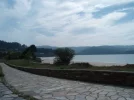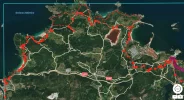- Time of past OR future Camino
- First: Camino Francés 2002; most recent: Norte/Primitivo 2019
Hi friends,
It's been a really long time since I've been in the forum. We've been in a holding pattern with our publisher on Northern Caminos for a while, though fortunately things are moving forward now, and I took on a second admin role at my school this year to help cover until we fill the job next year. The result has been professionally rewarding, though at the expense of pretty much everything else I'd like to be doing!
One thing we'll be moving forward is a guide focused primarily on the Inglés, but the main motivation for me with that is the opportunity to devote some attention to the Mar. In support of that, I've been devoting a ton of time to developing maps that cover all of the different routes--the Mar, the Cantábrico (and its coastal equivalent in Coruña), and the Mañon. This has been informed by my own gpx tracks from my scouting trip in 2016, the varied and conflicting gpx tracks online, skeletal maps developed by the Lugo Amigos, and a lot of virtual road-walking in Google Maps. In some stages, I had a much easier time of finding yellow arrows than I did when I was actually walking; I think it helped in those cases that Google's footage came from 2013.
What follows are the stages into which I'm breaking the Mar, with the distances that I've been able to pin down. Accommodation options for each stage are available here.
Stage 1: Ribadeo to Praia das Catedrais: 17.7km
>>In this stage, the Mar and Cantábrico are paired up. The Lugo Amigos' map suggests an inland approach from Ribadeo, but yellow arrows now show up on the coastal option and it's hard to find a compelling argument to take the interior approach.
Stage 2: Praia das Catedrais to Foz: 20.8km
>>Here, I suggest following the Cantábrico to the crossing of the Foz River, and then veering off onto the Mar in order to visit the basilica of San Martiño de Mondoñedo. From there, it's best to follow the direct road option into the center of Foz for the night, though it is possible to continue along the Mar, avoiding the center of Foz.
>>It is possible to take the Mar inland from Praia das Catedrais for the first half of the walk, though this is mostly road-walking and not nearly as scenic as the coast. Similarly, it's possible to stick to the coast for the full walk, but doing so would miss Mondoñedo, which is a major highlight of the route.
Stage 3: Foz to San Cibrao: 32.7km
>>Once again, I suggest a hybrid approach, following the Cántabrico along the coast from Foz to Burela, then turning inland, joining the Mar, and following it through the interesting Sargadelos park en route to San Cibrao. Those seeking a shorter day can easily break the walk in Burela.
>>This is the longest possible approach to the stage. If you follow the Mar directly, it's just 29km, though accommodation is much trickier. (The closest option en route from Mondoñedo is the Hotel Spa Mundo Buda.) Alternately, the Cantábrico direct to San Cibrao is 30.6km.
Stage 4: San Cibrao to Viveiro: 25km
>>The direct, inland route along the Mar avoids most of the coastline--it's a bit like tracing the outline of your palm while crossing over your fingers. It briefly hits the beach in Portocelo, but then veers in to Vilachá before returning to the coast in Esteiro.
>>Alternately, it's possible to follow the Cantábrico the full day, covering 29.3km and taking a few jaunts out to coastal viewpoints.
Stage 5: Viveiro to Cuiña: 31.1km
>>At this point, the differences between the Mar and Cantábrico become much more pronounced. The routes hold together through Covas, but then the Mar turns inland, cutting almost due west towards Cuiña/Ortigueira. The first half of the walk, through Riobarba and Ponte do Porto is almost entirely road-bound, but there's a bit more variety (a bit) after that. After the Ponte, the Mar overlaps with the Camiño de Mañón a Santo André de Teixido for significant stretches between here and Teixido, and then after that to Xubia/Ferrol
>>The coastal option, meanwhile, passes through O Vicedo, O Barqueiro, O Porto do Espasante, and Ortigueira, en route to Cuiña. All told, this covers 48.2km, so you'd need to devote two days to completing it.
Stage 6: Cuiña to Teixido: 21km
>>The two routes hold together for the first 10.5km of this walk. At that point, the Mar/Mañón veer inland, while the coastal option continues northward. Taking the coastal approach extends this stage to 38km, though it's possible to break the walk in Cariño.
Stage 7: Teixido to Xubia: 33.9km
>>The direct route here follows the Mañón, though it, too, splits partway through the walk, allowing you to intersect the Inglés in two different places near Xubia. Alternately, the Mar--in name, if not in marking--follows the coastline. This is a much larger trajectory, ultimately delivering you in Ferrol from the west, and spanning 79.7km. Obviously, you'll need to commit more than one day to this option, though there are good places to break up the walk in Cedeira, Valdoviño, Lavacerido, and Vila da Area.
If any of your experiences stand in contrast to any of this info, please get in touch! I don't expect this initial attempt to be flawless; indeed, my hope is to make it a bit more accessible for people eager to take the chance in order to continue generating more useful intel. More to come.
Dave
It's been a really long time since I've been in the forum. We've been in a holding pattern with our publisher on Northern Caminos for a while, though fortunately things are moving forward now, and I took on a second admin role at my school this year to help cover until we fill the job next year. The result has been professionally rewarding, though at the expense of pretty much everything else I'd like to be doing!
One thing we'll be moving forward is a guide focused primarily on the Inglés, but the main motivation for me with that is the opportunity to devote some attention to the Mar. In support of that, I've been devoting a ton of time to developing maps that cover all of the different routes--the Mar, the Cantábrico (and its coastal equivalent in Coruña), and the Mañon. This has been informed by my own gpx tracks from my scouting trip in 2016, the varied and conflicting gpx tracks online, skeletal maps developed by the Lugo Amigos, and a lot of virtual road-walking in Google Maps. In some stages, I had a much easier time of finding yellow arrows than I did when I was actually walking; I think it helped in those cases that Google's footage came from 2013.
What follows are the stages into which I'm breaking the Mar, with the distances that I've been able to pin down. Accommodation options for each stage are available here.
Stage 1: Ribadeo to Praia das Catedrais: 17.7km
>>In this stage, the Mar and Cantábrico are paired up. The Lugo Amigos' map suggests an inland approach from Ribadeo, but yellow arrows now show up on the coastal option and it's hard to find a compelling argument to take the interior approach.
Stage 2: Praia das Catedrais to Foz: 20.8km
>>Here, I suggest following the Cantábrico to the crossing of the Foz River, and then veering off onto the Mar in order to visit the basilica of San Martiño de Mondoñedo. From there, it's best to follow the direct road option into the center of Foz for the night, though it is possible to continue along the Mar, avoiding the center of Foz.
>>It is possible to take the Mar inland from Praia das Catedrais for the first half of the walk, though this is mostly road-walking and not nearly as scenic as the coast. Similarly, it's possible to stick to the coast for the full walk, but doing so would miss Mondoñedo, which is a major highlight of the route.
Stage 3: Foz to San Cibrao: 32.7km
>>Once again, I suggest a hybrid approach, following the Cántabrico along the coast from Foz to Burela, then turning inland, joining the Mar, and following it through the interesting Sargadelos park en route to San Cibrao. Those seeking a shorter day can easily break the walk in Burela.
>>This is the longest possible approach to the stage. If you follow the Mar directly, it's just 29km, though accommodation is much trickier. (The closest option en route from Mondoñedo is the Hotel Spa Mundo Buda.) Alternately, the Cantábrico direct to San Cibrao is 30.6km.
Stage 4: San Cibrao to Viveiro: 25km
>>The direct, inland route along the Mar avoids most of the coastline--it's a bit like tracing the outline of your palm while crossing over your fingers. It briefly hits the beach in Portocelo, but then veers in to Vilachá before returning to the coast in Esteiro.
>>Alternately, it's possible to follow the Cantábrico the full day, covering 29.3km and taking a few jaunts out to coastal viewpoints.
Stage 5: Viveiro to Cuiña: 31.1km
>>At this point, the differences between the Mar and Cantábrico become much more pronounced. The routes hold together through Covas, but then the Mar turns inland, cutting almost due west towards Cuiña/Ortigueira. The first half of the walk, through Riobarba and Ponte do Porto is almost entirely road-bound, but there's a bit more variety (a bit) after that. After the Ponte, the Mar overlaps with the Camiño de Mañón a Santo André de Teixido for significant stretches between here and Teixido, and then after that to Xubia/Ferrol
>>The coastal option, meanwhile, passes through O Vicedo, O Barqueiro, O Porto do Espasante, and Ortigueira, en route to Cuiña. All told, this covers 48.2km, so you'd need to devote two days to completing it.
Stage 6: Cuiña to Teixido: 21km
>>The two routes hold together for the first 10.5km of this walk. At that point, the Mar/Mañón veer inland, while the coastal option continues northward. Taking the coastal approach extends this stage to 38km, though it's possible to break the walk in Cariño.
Stage 7: Teixido to Xubia: 33.9km
>>The direct route here follows the Mañón, though it, too, splits partway through the walk, allowing you to intersect the Inglés in two different places near Xubia. Alternately, the Mar--in name, if not in marking--follows the coastline. This is a much larger trajectory, ultimately delivering you in Ferrol from the west, and spanning 79.7km. Obviously, you'll need to commit more than one day to this option, though there are good places to break up the walk in Cedeira, Valdoviño, Lavacerido, and Vila da Area.
If any of your experiences stand in contrast to any of this info, please get in touch! I don't expect this initial attempt to be flawless; indeed, my hope is to make it a bit more accessible for people eager to take the chance in order to continue generating more useful intel. More to come.
Dave







